 |
||
|
||
| ||
 CONTENTS
Everyone is aware of how a product can become popular: it must have a low price, a minimal set of standard 3D capabilities and satisfactory performance. As for video cards, they must be priced up to $100 to be in demand. What in the GeForce4 MX can push off, taking into account that such cards have an acceptable speed for their price? First and foremost, they don't have new wanted functions such as multilevel anisotropy and pixel shaders, not to mention software implementation of vertex shaders. That is why users tend to ATI and other companies. Unfortunately, ATI is the only company which offers a viable alternative of the GeForce4 MX (with even richer functions). This is the RADEON 9000 Pro. Such cards are frequent guests in our lab. But today we will turn to SIS which deals in production of video chips for a long time already. But till recently all solutions based on the SIS 3D chips had inferior quality. Only the Xabre 400 could put an end to the agonizing image of the firm. Several video cards on this GPU were examined in our lab before. Theoretical materials and reviews of video cards which concern functional
properties of the
The strongest points of the Xabre 400 are its relatively low price, decent performance and good 2D quality of video cards and their reliability; the weakest points are lacking anisotropic filtering, a trick with turbo texturing (simplified texture detailing and bilinear filtering), an extremely low speed of execution of pixel shaders and missing T&L. Besides, the drivers are still buggy - in some games the artifacts are well noticeable. But while the Xabre 400 is fighting against video cards in the price niche of $70-75 (and does it successfully), the new Xabre 600 is going to become a rival for cards priced at around $100. Will this Xabre be able to become the best offer in this segment or at least take firm ground? For today we have the following GPU SIS Xabre line:
The Xabre 400 is already as transparent as glass. But what about the Xabre 600? Is it the same Xabre 400 with just lifted up frequencies due to the new fabrication process or something new? According to SIS, this is a completely new solution.
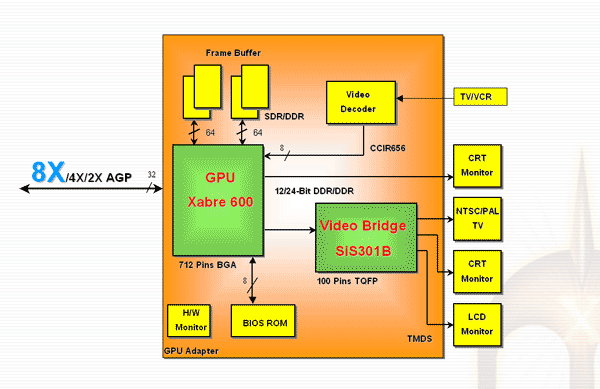 The general block diagram of the Xabre 600 based card shows nothing new: the same two 64-bit memory controller, 301 external coprocessor with the second RAMDAC and TV-out codec etc. SIS positions its new product as a competitor against GeForce4 MX and RADEON 9000 Pro which must outpace them and come close to the Performance sector:
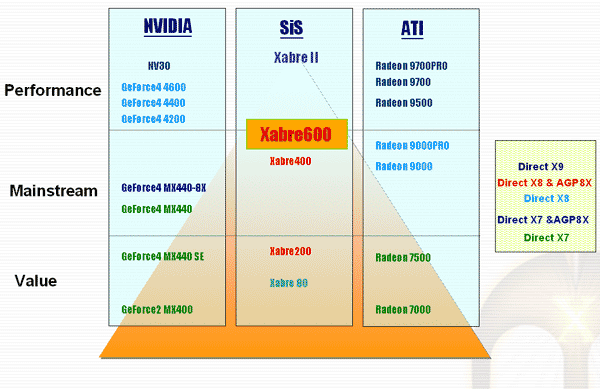 As for the position inside the line - this SIS's solution is a bridge to a new Xabre II which will be released next year:
 All new features of the Xabre 600 are reflected in a single name Xmart which covers:
 Nothing special - they just glorify the AGP 8x bus which doesn't have much to offer even for top models, however, it makes sense to use it for a 64MB card to accelerate texture transfer.
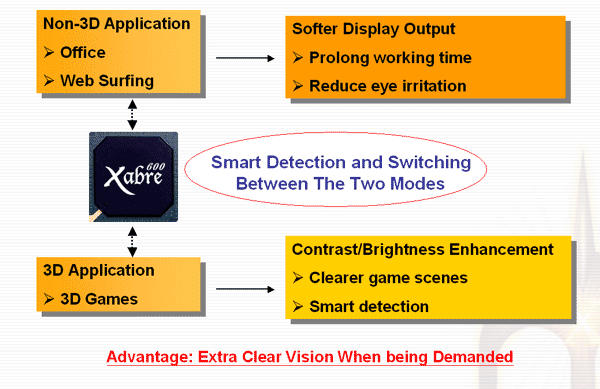
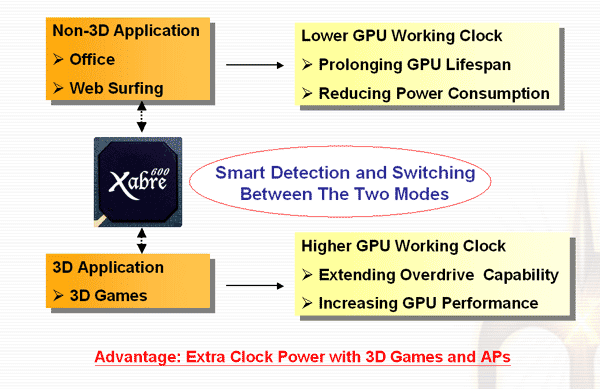 So, the new Xmart Technology consists of three parts and is available in the new driver version called Xminator II:
 How funny the names are :-). Look at the item in the new drivers named Vertexlizer. This is exactly operation of vertex shaders. Do you remember we said the Xabre 400 had no hardware support of vertex shaders? The Xabre 600 got this support codenamed Vertexlizer. However that may be, but this is not a hardware support because it came with just new drivers, not with a new chipset. Well, the Xabre 400 also had all those Xmart components including the Vertexlizer. It's possible that the Xabre 400 did have vertex shaders but they weren't realized in the drivers. But it's hardly possible. Most likely, this is just software emulation in the drivers reporting about hardware vertex shaders. Probably, they wanted to bind the new technology to the Xabre 600 but by mistake they forgot to disable it in the Xabre 400. Below you will see that the Xabre 600 is just an overclocked version of the Xabre 400. CardThe reference card has
 and a beautiful golden cooler:   The GPU's package is bigger compared to the Xabre 400 in spite of the finer fab process of the Xabre 600; it seems that the latter still has severe requirements for cooling. Overclocking
Attention!

By this warning we mean that overclocking is not a normal mode, and you should preserve your card from damages. Test system and driversTestbeds:
The test system was coupled with In the tests we used SiS's drivers of ver.3.07. Here are their settings:  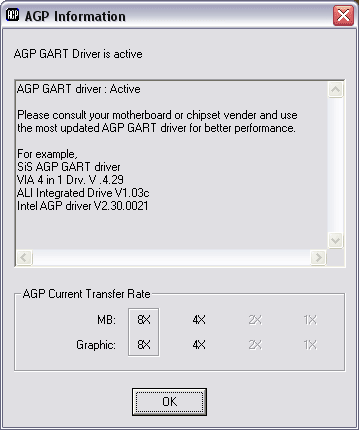 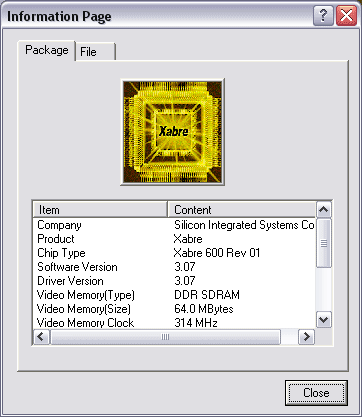 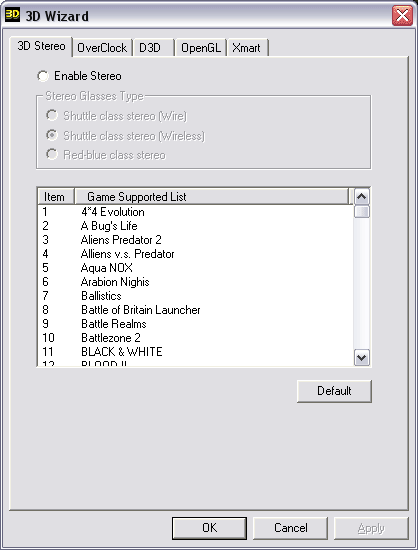
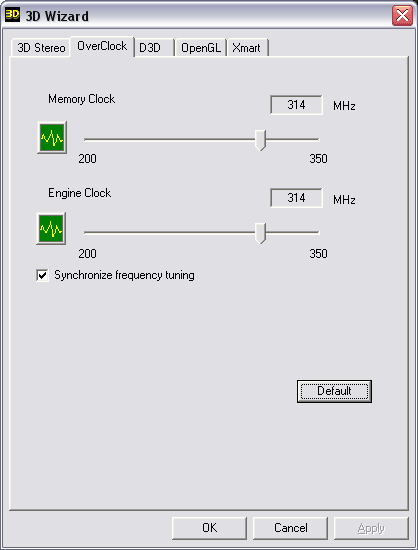 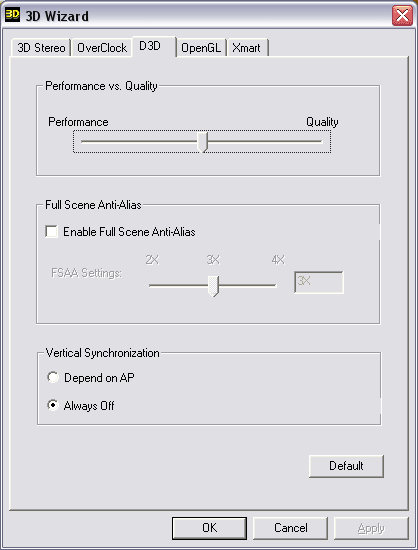
 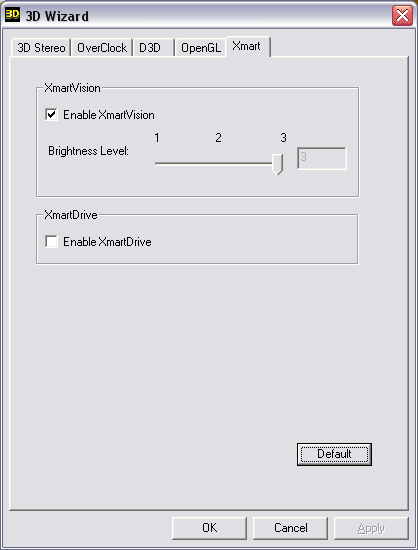 For comparison we used the following cards:
Test resultsBefore we start examining 2D quality I should say that there is no a complete technique of objective estimation of this parameter because:
As for the tested samples, together with the ViewSonic P817 monitor and BNC Bargo cable the cards showed excellent quality at the following resolutions and frequencies:
3D graphics, MS DirectX 8.1 SDK - extreme testsSo, for thorough examination of different parameters of the chips we used modified examples from the final version of DirectX SDK (8.1). Optimized MeshThis test defines a real maximum throughput of an accelerator as far as triangles are concerned. For this purpose it uses several simultaneously displayed models each consisting of 50,000 triangles. No texturing. The dimensions are minimal - each triangle takes just one pixel. It must be noted that the results of this test are unachievable for real applications where triangles are much greater, and textures and lighting are used. The results are given only for 3 rendering methods - model optimized for the optimal output speed (with the size of the internal vertex cache on the chip accounted for) - Optimized, Unoptimized original model, and Strip - unoptimized model displayed in the form of one Triangle Strip:
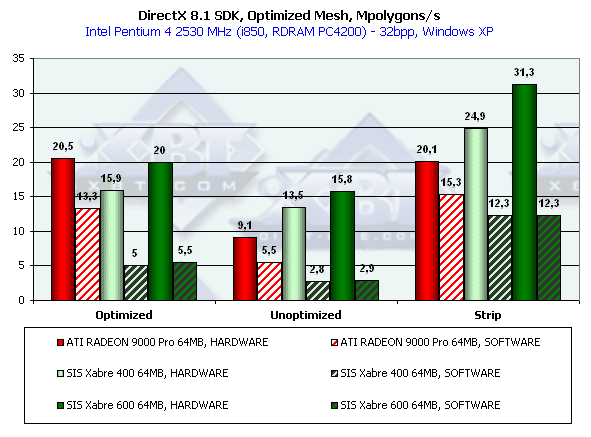 In this test the Radeon takes the lead in the optimized model, probably, at the expense of the better vertex caching; in the other cases the first position belongs to the Xabre. Interestingly that in the TCL software emulation the Radeon is ahead - probably its connection with the AGP and caching are organized better. Vertex shader unit performanceThis test allows determining the maximum performance of the vertex shader unit. It uses a complex shader which deals with both type-transformation and geometrical functions. The test is carried out in the minimal resolution in order to minimize the shading effect. The Z buffer is disabled and HSR can't affect the results:
 The identical scores in case of the software and hardware vertex shaders of the SIS's GPU proves our supposition about the program emulation. But the emulation in the drivers is executed at the same speed as at the level of API DX - therefore, the drivers just rely on the DX here. In case of the software emulation the Radeon is far ahead. If SIS stakes on the emulation why don't they consider transfer of geometry via AGP b-caching at the level of the Radeon 9000? But this advantage of ATI doesn't mean that they should go with the software emulation as well, as in this synthetic test the processor has nothing to do anymore, while in real applications it will have other tasks to cope with. Vertex matrix blendingThis T&L's feature is used for verisimilar animation and model skinning. We tested blending using two matrices both in the "hardware" version and with a vertex shader that implements the same function. Besides, we obtained results in the software T&L emulation mode:
 SIS loses to ATI by a small margin. It's interesting that the software and hardware implementation gives equal results for the Xabre 400, but different ones for the Xabre 600, with the software emulation being better! Probably SIS tried to optimize the emulation, but the attempt failed. EMBMIn this test we measure performance drop caused by Environment mapping and EMBM (Environment Bump). We also measure a fillrate in case of single texturing. We set 1280x1024 because exactly in this resolution the difference between cards and different texturing modes is the most discernible:
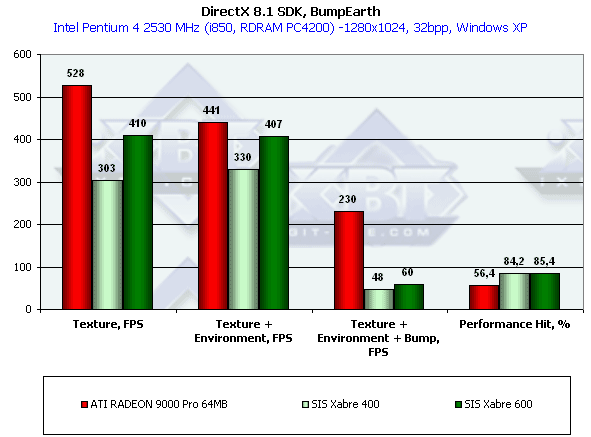 EMBM works, but the drop is significant. In case of the custom texturing and environmental mapping it looks OK. In general, the Radeon runs slower, but faster compared to the previous Xabre 400. Performance of Pixel Shader 1.0We used again a modified example of the MFCPixelShader having measured performance of the cards in high resolution in implementation of 5 shaders different in complexity, for bilinear-filtered textures:
The pixel shaders are evidently of the hardware nature, and as the complexity level of the shader grows SIS catches up and even outedges ATI. So, the pixel shaders are here, the vertex shaders are emulated. And they are emulated less efficiently than the forced emulation of the ATI's solution. Now we have the synthetic tests of the 3DMark2001: 3D graphics, 3DMark2001 SE - synthetic testsAll measurements in all 3D tests were taken in 32-bit color. Fillrate  So, the Xabre 600 outshines the Xabre 400. But that's all. It's still behind NVIDIA and ATI, though the gap is not that great. Later we will see whether this lag will tell upon real applications. Scene with a large number of polygonsIn this test you should pay more attention to the minimal resolution where the fillrate makes almost no effect: 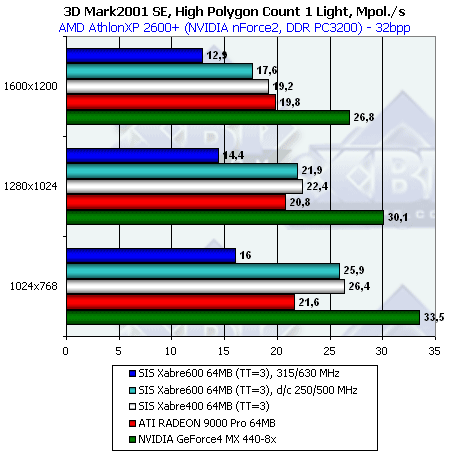  While it's not very surprising that NVIDIA overtakes ATI, the fact that the Xabre 400 has better vertex performance by 1.5 than the Xabre 600 is unprecedented. I could assume that some optimization in the drivers of the Xabre 600 worked bad and brought negative results (remember the strange results of the matrix blending from the DX 8.1 SDK), but at the lower frequency the scores of the Xabre 600 have almost reached the level of Xabre 400. I'm really at a loss. But if you remember some time ago the new version of the 3D Mark brought some corrections, and the Xabre 400 started to perform much better. And now one more new version - and the new SIS card has its scores much worse. What does it mean? Maybe the optimization of the 3D Mark 2001 for the Xabre 400 wasn't complete? Unfortunately, the 3D Mark 2001 is not an open benchmark. Bump mappingLook at the result of the synthetic EMBM scene:
 As the DX SDK test showed, SIS has no chance! And now the DP3 relief:
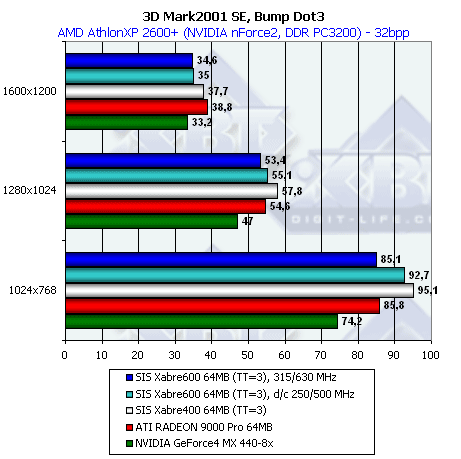 And here the Xabre 600 even outdoes its rivals in the moderate resolution. Vertex shaders
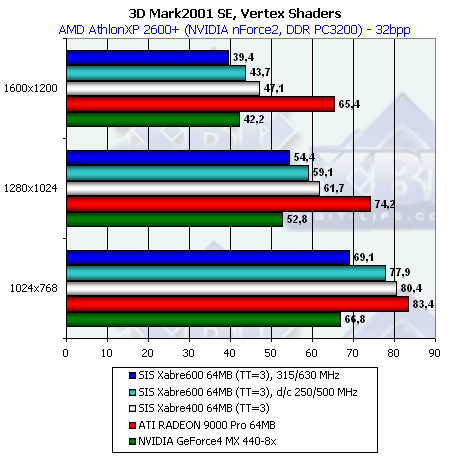 The situation is strange and inverted as well! Pixel shader
Contrary to the DX SDK, all Xabres perform badly. Probably because of the EMBM with pixel shaders - this is not where SIS shines. Well, pixel shaders of SIS are not that bad until the EMBM is involved. Now look at the more complex benchmark - Advanced Pixel Shader.
Sprites ATI takes the palm, but SIS sticks firmly to its position - it falls behind NVIDIA by just a slight margin. So, the behavior of the 3D Mark 2001 is really strange as far as vertex performance is concerned. It should be investigated and discussed in the forum; maybe we should also ask the developers of the Xabre about it. Why doesn't the speed jump up while the frequency is falling down? In the sphere of pixel shaders it's well matched with the DX SDK tests. And in this respect the Xabre 600 looks competitive when it doesn't come down to EMBM. For estimation of 3D performance of the card we used the following benchmarks: 3D graphics, 3DMark2001 - game tests3D MARKS Consider the dark blue and hatched bars. Well, it loses to the ATI RADEON 9000 Pro (even at TT=3) and slightly outscores the GeForce4 MX440-8x Game1 Low Details While at TT=3 the Xabre 600 is ahead (except 1600x1200), at TT=1 the newcomer yields to the RADEON 9000 Pro and GeForce4 MX440-8x. Game2 Low Details Well, the absolute defeat of the Xabre 600. Game3 Low Details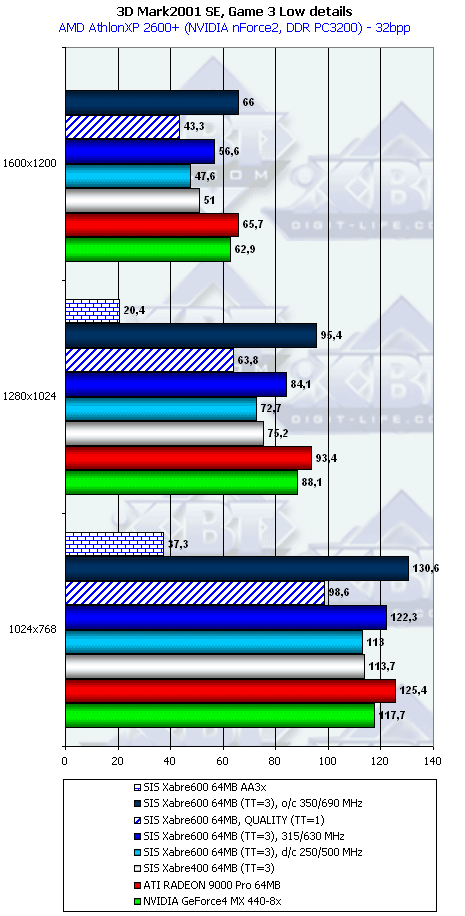 The same. Game4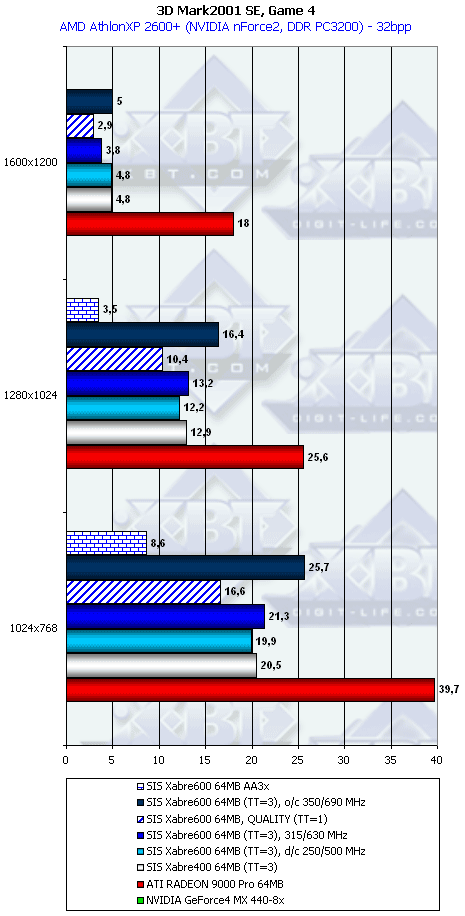 No comments. The Xabre 600 is hardly a killer of the RADEON 9000 Pro or the GeForce4 MX440-8x. In most cases it loses. The competitors were tested at the highest detail level and 3D quality, that is why they should be compared to the Xabre 600 at TT=1. Well, it's an absolute failure. 3D graphics, game testsFor estimation of 3D performance in games we used the following tests:
Quake3 Arena, Quaver The ICD OpenGL of the Xabre is so well optimized for the Quake3 that it manages to win from the rivals. And even at TT=1 the card goes on a par with the RADEON 9000 Pro. Serious Sam: The Second Encounter, Grand Cathedral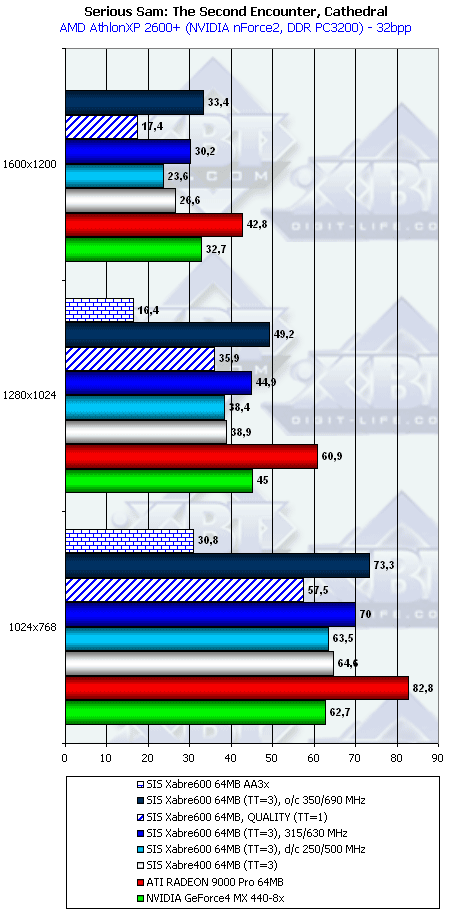 Here the RADEON 9000 Pro is beyond the competition, the Xabre 600 fights against the GeForce4 MX440-8x. Return to Castle Wolfenstein (Multiplayer), Checkpoint As the RtCW uses the engine of the Quake3, the situation is similar to the Quake3, where the Xabre 600 is a winner. Comanche4 DEMO The SIS falls into the last position. Unreal Tournament 2003 DEMO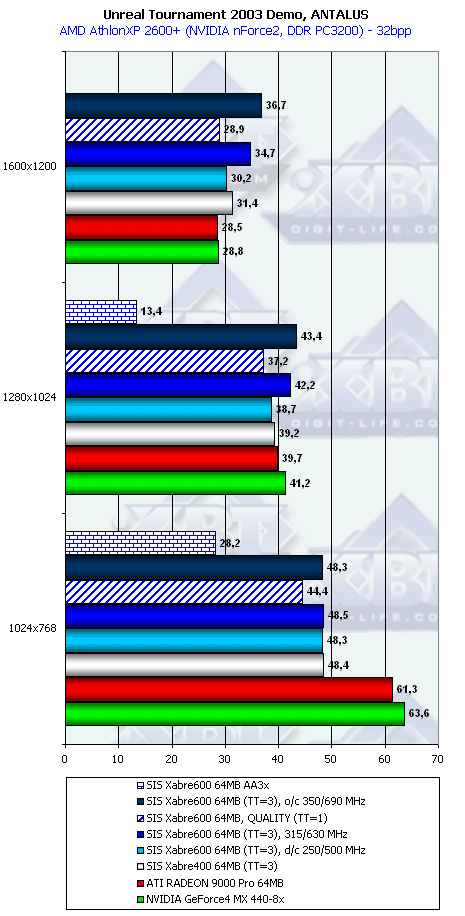 3D qualityConclusionSo, we have examined the new product from SIS which, as it turned out, is just an overclocked version of the Xabre 400, because the Xabre 600 is produced on the finer - 0.13 micron - technological process. With the launch of the Xabre 600 SIS announced new technologies which are integrated into the driver named Xminator II, but they are not the hardware features, nor they are peculiar only to the Xabre 600. They implemented the software emulation of the vertex shader, made the driver handling better, brought in new settings for the Xabre. Well, this is just the accelerated version of the Xabre 400 with slight alterations. But it doesn't matter much for an end-user; what matters is reliable and speedy operation of the product offered at a moderate price. In the old games of 1999-2001 the Xabre 600 performs quite well, it competes successfully against the GeForce4 MX440-8x and RADEON 9000 Pro. But in new games which involve new technologies based on shaders (EMBM and pixel and vertex shaders), the Xabre 600 falls behind. So, the performance is comparable to the leaders of sales. But for better promotion of the SIS Xabre 600 it must have not just a comparable, but lower price. And it's not just because of the vertex shaders. It's clear that with all other conditions being equal a user would prefer NVIDIA or ATI. Besides, if there are some compatibility or performance problems, even the price cuts won't help. Success of this product will entirely be determined by its price. Whether it's going to be popular or not depends on the policy of SIS and its partners. Also remember that the Xabre 600 has much inferior performance in the Quality mode (TT=1). This is the mode where the competitors have already won the authority and boast of a very good correlation of price, quality and speed. In future we will also try to clarify the issue related with the strange behavior of the 3D Mark 2001. For the fuller comparison characteristics of video cards of this and
other classes address our 3Digest.
Write a comment below. No registration needed!
|
Platform · Video · Multimedia · Mobile · Other || About us & Privacy policy · Twitter · Facebook Copyright © Byrds Research & Publishing, Ltd., 1997–2011. All rights reserved. | ||||||||||||||||||||||||||||||||||||||||||||||||||||||||||||